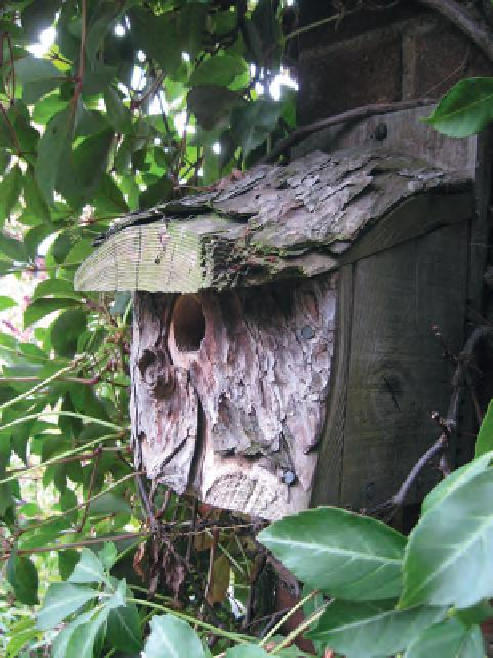Agriculture Reference
In-Depth Information
(a)
(b)
16
Figure 16.6
(a) A blue tit box; (b) a blue tit feeder
Gardeners having ponds should remember that
hedgehogs quite commonly fall into the water at night,
and will avoid drowning if a part of the pond wall has a
slope or a small ramp provided for their escape.
Frogs and toads
commonly leave their ponds in damp
weather and may contribute greatly to the control of
slugs and ground-living insect pests. The
common
frog
(
Rana temporaria
) is smooth-skinned, about 7
cm in length, and greenish-brown or yellow in colour.
It is seen most commonly from March to October.
The frog's egg mass is laid in spring as a large round
clump, usually in shallow water. The species' numbers
have decreased in the countryside in recent years,
and it is most commonly seen nowadays in garden
ponds. The introduced green and brown
marsh frog
(
Pelophylax ridibundus
), found mainly in Kent and
East Sussex, is large (up to 17 cm in length), has dark
blotches on its body and often has a yellow stripe
down its back. The
common toad
(
Bufo bufo
) has a
grey or brown, warty appearance. The female may
reach 9 cm in length, while the smaller male is more
commonly 6 cm. The toad's egg mass is laid in spring
in long strings. This species may be active all year
round in the UK when the weather is mild. It prefers
deep ponds. The introduced
midwife toad
, which
can reach 5 cm in length, is found most commonly in
Bedfordshire, South Yorkshire and Devon. The male
holds on to the egg mass on his back (hence the
common name). This species makes a characteristic
high-pitched piping sound. These amphibians
commonly leave their ponds in damp weather and
may contribute greatly to the control of slugs and
ground-living insect pests.
Lacewings
(e.g.
Chrysopa carnea
) are pale green
insects, 1.5 cm, which fold their transparent wings
over their bodies when at rest. Several hundred eggs
are laid per year, each on the end of fine stalks, on
the underside of leaves. They are useful horticultural
predators, their hairy larvae (Figure 16.7b) eating
aphids and mite pests, often reaching the prey in leaf
folds where ladybirds cannot reach. They also are now
used commercially in greenhouses.
The 40 British species of
ladybird
beetle (Figure 16.8)
are a welcome sight to the gardener. Almost all are
predatory. The red
seven-spot ladybird
(
Coccinella
7-punctata
) emerges from the soil in spring, mates and
lays about 1,000 elongated yellow eggs on the leaves
of a range of weeds such as nettles, and crops such
as beans, throughout the growing season. Both the
emerging slate-grey and yellow larvae and the adults




